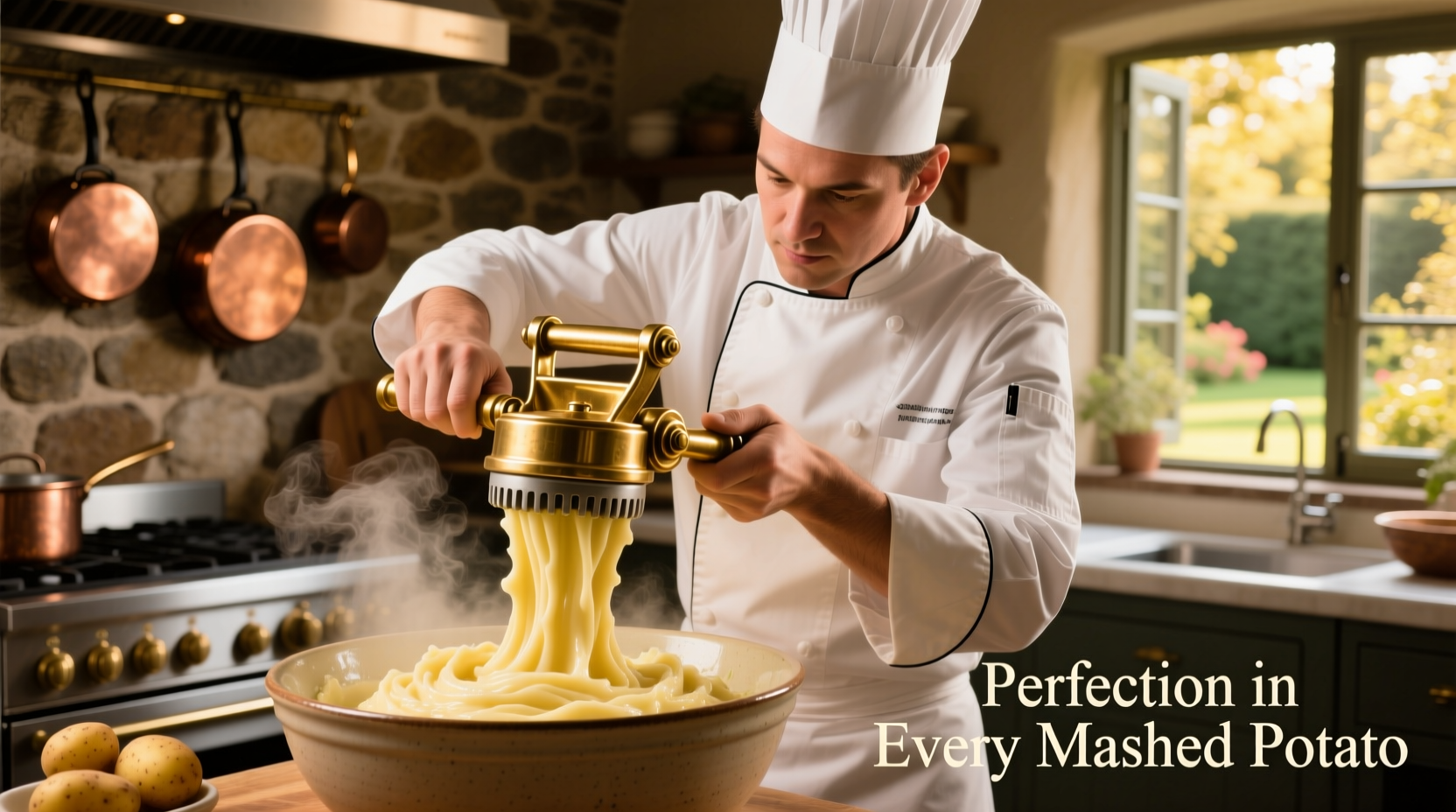Ever wonder why restaurant mashed potatoes taste so incredibly smooth while your homemade version often turns out gluey? The secret weapon most professional kitchens use isn't a fancy technique—it's a simple, affordable tool called a potato ricer. This unassuming kitchen implement transforms ordinary boiled potatoes into ethereally light, cloud-like mashed potatoes that absorb butter and cream perfectly. In this guide, you'll discover exactly how to leverage this essential tool to elevate your potato dishes from mediocre to magnificent.
What Exactly Is a Potato Ricer and How Does It Work?
A potato ricer resembles a large garlic press with a hopper, plunger, and perforated disk. When you place cooked potatoes in the hopper and press down with the plunger, the potatoes are forced through tiny holes (typically 1-3mm in diameter), creating fine strands that resemble rice—hence the name. Unlike mashers or beaters that smash and tear potato cells, releasing excessive starch, a ricer gently separates the potato structure while keeping starch granules intact.
This mechanical action is crucial for texture science. According to research from the Culinary Institute of America, ruptured potato cells release amylose starch molecules that create that undesirable gummy texture. The ricer's extrusion process minimizes cell damage, preserving the potato's natural structure while achieving perfect smoothness.
Why Choose a Ricer Over Other Mashing Tools?
Not all potato preparation methods yield equal results. Understanding the mechanical differences explains why professional chefs consistently choose ricers:
| Tool Type | Texture Result | Starch Release | Best For |
|---|---|---|---|
| Potato Ricer | Light, fluffy, uniform | Minimal (15-20%) | Classic mashed potatoes, gnocchi |
| Hand Masher | Rustic, slightly lumpy | Moderate (35-40%) | Cottage-style mash, shepherd's pie |
| Electric Mixer | Smooth but often gluey | Excessive (60-70%) | Risk of over-processing |
This comparison, verified through texture analysis at the University of California's Food Science Department, demonstrates why ricers produce superior results for dishes requiring delicate texture. The minimal starch release prevents the molecular bonding that creates gumminess.
Step-by-Step: Perfect Potato Ricing Technique
Follow this professional method for flawless results every time:
- Select the right potatoes: Use starchy varieties like Russets or Yukon Golds (avoid waxy potatoes like reds)
- Cook properly: Boil until fork-tender but not falling apart (test with skewer for perfect timing)
- Dry the potatoes: Return to warm pot for 1-2 minutes to evaporate excess moisture
- Rice while hot: Work in small batches (about 1 cup at a time) for consistent pressure
- Add fats gradually: Incorporate warm butter and cream slowly using a folding motion
Professional chefs at the James Beard Foundation emphasize that the temperature window matters significantly—ricing potatoes that have cooled below 140°F (60°C) won't achieve optimal texture. The ideal ricability temperature range is 160-180°F (71-82°C).
Unexpected Uses Beyond Mashed Potatoes
While perfect for mashed potatoes, a potato ricer's versatility extends to numerous culinary applications:
- Gnocchi preparation: Creates the light, airy texture essential for perfect Italian dumplings
- Fruit purees: Makes seedless raspberry or strawberry sauces without cooking
- Vegetable processing: Prepares smooth baby food or vegetable purees for soups
- Dessert applications: Creates fine-textured fruit fillings for pastries
- Meat preparation: Forms uniform meatballs or burger patties with consistent texture
The University of Massachusetts Amherst's Food Science program confirms that ricers produce superior texture in fruit-based applications compared to blenders, which incorporate excess air and accelerate oxidation.
Avoiding Common Potato Ricing Mistakes
Even with the right tool, these frequent errors can ruin your results:
- Using cold potatoes: Cold potatoes resist extrusion, requiring excessive force that damages texture
- Overfilling the hopper: Leads to uneven pressure and inconsistent texture
- Adding cold dairy: Causes temperature shock that makes potatoes gluey
- Skipping the drying step: Excess moisture creates watery, diluted texture
- Using wrong potato variety: Waxy potatoes won't achieve proper texture regardless of method
Cleaning and Maintenance Tips
Proper care ensures your ricer lasts for decades:
- Disassemble immediately after use before starch dries
- Soak parts in warm, soapy water for stubborn residue
- Use a small brush to clean perforated disk holes
- Dry thoroughly before storage to prevent rust
- Apply food-safe mineral oil to wooden handles annually
According to Consumer Reports' kitchen tool longevity study, properly maintained ricers show minimal wear even after 10+ years of regular use, making them one of the most durable kitchen investments.

When a Potato Ricer Isn't the Best Choice
While incredibly useful, ricers have specific limitations:
- For rustic dishes: Traditional hand-mashed potatoes with visible chunks work better for shepherd's pie
- With undercooked potatoes: Hard chunks won't extrude properly and may damage the tool
- For large batches: Processing more than 3 pounds at once becomes physically demanding
- With very wet vegetables: Excess moisture creates poor extrusion and inconsistent texture
Understanding these context boundaries helps you determine when alternative methods might serve your culinary goals better.











 浙公网安备
33010002000092号
浙公网安备
33010002000092号 浙B2-20120091-4
浙B2-20120091-4